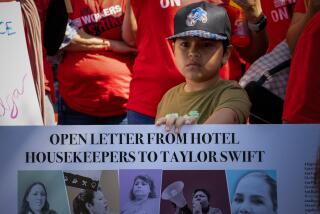The Web without the wires
- Share via
With all the hype about wireless access, business travelers may think they’re never far from a high-speed Internet connection.
The truth? Far from it.
“WiFi” stands for wireless fidelity, and the technology refers to users’ ability to get a high-speed pipeline to the Web — with a laptop computer or personal digital assistant — without a cord.
Here’s how it works:
An Internet provider transmits an original broadband signal through wires to an access point in a bookstore, coffeehouse, hotel, airport, etc. The signal is then relayed out in a radius of about 300 feet, creating a “hot spot.” That signal is available to anyone with a properly equipped laptop or PDA.
There also can be multiple hot spots next to one another, say, at an airport or hotel, so that WiFi is available throughout.
The number of hot spots is growing rapidly. Thousands of them exist at airports, hotels, bookstores and coffeehouses around the world.
Some people have established hot spots in their homes, so multiple users can have wireless access. WiFi providers such as T-Mobile USA and SBC Communications are racing to add more areas where travelers can log on.
Some companies are selling devices that combine WiFi with a cellular phone. And WiFi is available at 30,000 feet. Lufthansa offers WiFi on its Los Angeles-to-Munich flights using a Boeing technology called Connexion. Other carriers are expected to offer it in the coming months.
But on the ground, hot spots are still limited in size and can be, well, spotty. A typical WiFi signal extends only 300 to 400 feet and can be found only in certain lounges or conference rooms in many airports and hotels.
The user often has to search for the nearest hot spot and hope it’s not too far away. (There are free software products such as T-Mobile’s Connection Manager and websites, including https://www.jiwire.com , that can locate them for you.)
“Like the name suggests, it’s a spot,” said Shiv Bakhshi, mobile and WiFi director at IDC, a consulting firm in Framingham, Mass. “It’s not ubiquitously available.”
Many airports do not yet have WiFi throughout, including two of the busiest — Los Angeles International and Chicago’s O’Hare. So business travelers waiting for a flight might not have access as they sit next to their airline’s boarding gate. They would have to walk to the nearest hot spot in the airport, which may be inconvenient.
“We are hoping more of the airports decide they want to deploy WiFi,” said Pete Thompson, a WiFi director at T-Mobile.
Andrew Jones, a scientist at USC’s Space Sciences Center who subscribes to T-Mobile’s WiFi service, knows the problem. He often flies out of LAX’s Terminal 1, which doesn’t have WiFi access. “Then you fly to somewhere like Logan [airport] in Boston, which is wired, but it has a different service carrier,” Jones said. “So you either have to pay extra money or forgo the pleasure of checking your e-mail.”
Even if a hot spot is available, employees may be blocked from entering their corporate Internet networks. Some companies have been slow to make access available because they’re worried that current WiFi technology isn’t secure enough.
WiFi networks are more vulnerable than wired ones because the signals can be plucked from the air if hackers have the right equipment. But there are precautions — including encryption and passwords — that companies and individuals can employ to improve security, and newer WiFi products are being equipped with stiffer safeguards.
Hotels walk the line
The WiFi option has arrived at an awkward time for the hotel industry. Many chains are in the middle of outfitting their facilities with wired Internet connections. Now they must decide whether to add WiFi.Robert Machen, a vice president of Hilton Hotels Corp., calls it “a transition period between wired and wireless.”
Some hotels offer only a wired connection; others have added WiFi service in public areas. At the Hilton Hawaiian Village in Honolulu, for instance, it’s not unusual to see someone reading e-mail by the pool.
But what about the business traveler who has just checked into a room at 10 p.m. after a long flight, wants to read e-mail before bed and is in no mood to walk back to the lobby for a WiFi connection?
Depending on the hotel, the room may or may not have WiFi access or even a wired Internet connection.
“It just gets frustrating after a while,” said Matthew Berger, an intellectual-property lawyer with Morrison & Foerster in Los Angeles who spends two weeks a month on the road. Berger estimates he’s able to get a connection, either wired or with WiFi, 75% of the time. Otherwise he does without.
Internet availability, both wired and wireless, is growing rapidly at hotels. Berger and other U.S. hotel guests last year spent about $130 million for either a wired or WiFi connection, and that figure is expected to triple in 2004, according to In-Stat/MDR, a technology research firm in Scottsdale, Ariz.
The firm said almost 3,000 North American hotels could handle either wired or WiFi Internet connections last year, and it expects that number to soar to 12,000 by 2008. That means about one in four domestic hotels would have access.
About half of all business travelers say high-speed Internet access influences their choice of hotels, according to Yesawich, Pepperdine, Brown & Russell, a travel marketing firm based in Orlando, Fla. Road warriors also are quickly adopting wireless as their favored technology, said Machen. And as some hotels try to meet this demand, travelers without a WiFi setup may find themselves stranded.
Carl Winston, director of the hospitality and tourism management program at San Diego State University, recently stayed at a Hyatt Regency in Sacramento, which offers WiFi throughout the property. But it did Winston no good, because his laptop doesn’t have a wireless connection.
Unlike many hotels that offer only wireless service, the Hyatt didn’t have a special adapter that would allow Winston to plug in. So he couldn’t connect.
Most laptops made today have built-in WiFi access, T-Mobile’s Thompson said. For those that don’t, WiFi cards, costing from $20 to $120, can make laptops and PDAs ready for WiFi.
Travelers can connect to the Internet in another way: Cellular subscribers can buy a data card they slide into their laptop, and “that data card will work anywhere my cellphone will work,” IDC’s Bakhshi said. “I don’t have to look for a hot spot.”
But there’s a catch: The data cards don’t have the data capacity of WiFi. If you want to access big files or if other users in your immediate area are using similar cards on your network, your connection will slow down.
T-Mobile and other providers are rolling out integrated cards that automatically switch a user’s connection from the cellular network to WiFi when a hot spot is in range.
Cold cash for hot spots
Before anyone can connect, there’s the matter of fees.You can pay as you go or have a monthly or annual subscription. Providers typically have monthly rates ranging from $20 to $40, and 24-hour passes at about $10. Or you can pay $5 or $6 for the first hour and 10 cents or so for every minute after that.
What if you have a monthly subscription to one provider and the hot spot you want to use is handled by another? You’ll probably have to pay the local provider an extra fee, by the hour or for the day; the fee probably would be required upfront and could be paid by credit card when you log on. Providers, however, are increasingly setting up reciprocal deals so that you can connect without having to stop to pay additional fees, much as “roaming” works with a cellphone.
As for hotels, Berger figures he has paid anywhere from $5 to $20 a day for Internet access, both wired and WiFi. “And sometimes that comes on top of paying $500 for the room,” he said.
For the most part, less expensive chains such as Hampton Inn sometimes offer free Internet access, and full-service hotels tend to charge. The typical fee is $10 for a 24-hour period, and that is often bundled with free local telephone calls.
But eventually the fees will decline or disappear, predicted Murray Newton, director of rooms and revenue at the Hilton Santa Clara. He said an Internet connection, wired or not, will be just another free amenity in the room, like a television.




